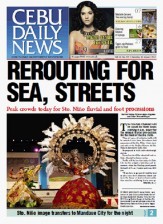
Then at 1 p.m., all vehicular traffic will be rerouted away from the solemn foot procession of the Sto. Niño, which starts and ends at the Basilica Minore del Sto. Niño in downtown Cebu City.
Be prepared to walk and wade through crowds.
Several roads will be closed off and vehicles directed to detour routes.
Traffic will be heaviest today in Cebu City for the religious festivities and tomorrow, when the Sinulog grand parade kicks off at 9 a.m. Sunday and runs till 8 p.m.
“If you have to go out, it would be best to play your day’s itinerary ahead and leave the house at least an hour earlier than usual to avoid being late to your appointments,” advised Rafael Yap, head of the City Traffic Operations Management (Citom).
Two corridors are especially important.
“The South Coastal Road to MacArthur Avenue (in the North Reclamation Area) and M. Velez Avenue to Escario Street will be very crucial,” said Yap, “because they are the only roads to pass going south and north during the rerouting for the solemn procession and grand parade.”
MacArthur Avenue is an access road for vehicles heading to and coming from the South Coastal Road.
Human traffic is already very heavy near the basilica where 10 Masses daily are held and in downtown Cebu City.
About 400 Citom personnel will be fielded this weekend to cope with the extra load on the road.
For the sea procession, about 160 vessels—from motor bancas and yachts to interisland boats—signed up with the Coast Guard, said Cebu commander Rolando Punzalan.
Policemen, port police, the Coast Guard and military will be deployed in the area, some on rubber boats.
A Navy plane will fly overhead and drop flower petals and prayer petitions on the flotilla. Two nomad planes of the Indiana Aerospace University (IAU) will also join the sky drop.
The fluvial parade is a reenactment of the historical arrival of Ferdinand Magellan’s galleons “at the mouth of the cove of Cebu called Mandaue” in 1521, bringing the image of the Sto. Niño.
It is preceded by a dawn Mass at 4 a.m. and foot procession from the St. Joseph’s Shrine in Mandaue City to the Ouano Wharf, where images of the Sto. Niño and Our Lady of Guadalupe are placed on a white “galleon.”
The flotilla sets sail at 6 a.m. and heads for Pier 1 in Cebu City where it will be greeted by devotees and escorted by devotees to the Basilica Pilgrim Center for the reenactment of Cebu’s first Mass and baptism.
The image of the Holy Child used in the fluvial parade is a replica of the original Sto. Niño de Cebu found in the basilica.
Msgr. Cris Garcia, custodian of this “pilgrim image,” said it was special because this was blessed by Pope John Paul II in 1990.
The Cebu priest had brought the image with him during a pilgrimage to Castel Gandolfo, the papal summer residence in Italy.
Upon seeing the image, John Paul II recognized it immediately and exclaimed, “The Sto. Niño of Cebu!” Garcia recalled. (This image is now kept in the Archdiocesan Shrine of Hesus Nazareno in Cansojong, Talisay City.)
Then at 1 p.m., the solemn foot procession will begin.
Cebu Archbishop Jose Palma, who is celebrating his first Fiesta Señor as archbishop, said he plans to join the 6.8-kilometer prayer walk but it depends on his health.
“It really depends on my condition tomorrow. But I will surely be there during the opening and receiving ceremonies,” he told reporters.
He advised devotees to stay orderly and maintain the solemnity of the procession.
Some devotees get rowdy and rush to the carroza to touch the glass case that encloses the image of the Sto. Niño.
“I believe the Sto. Niño would be more happy if the procession is orderly unlike what happened in other places where there were accidents and injuries. The Sto. Niño will surely be unhappy if there will be injuries,” said Palma, an apparent reference to the chaotic procession of the Black Nazarene in Quiapo last week.
And if health reasons prevent one from joining the procession, which would last until past 6 p.m., he said, “Sto. Niño would understand.”